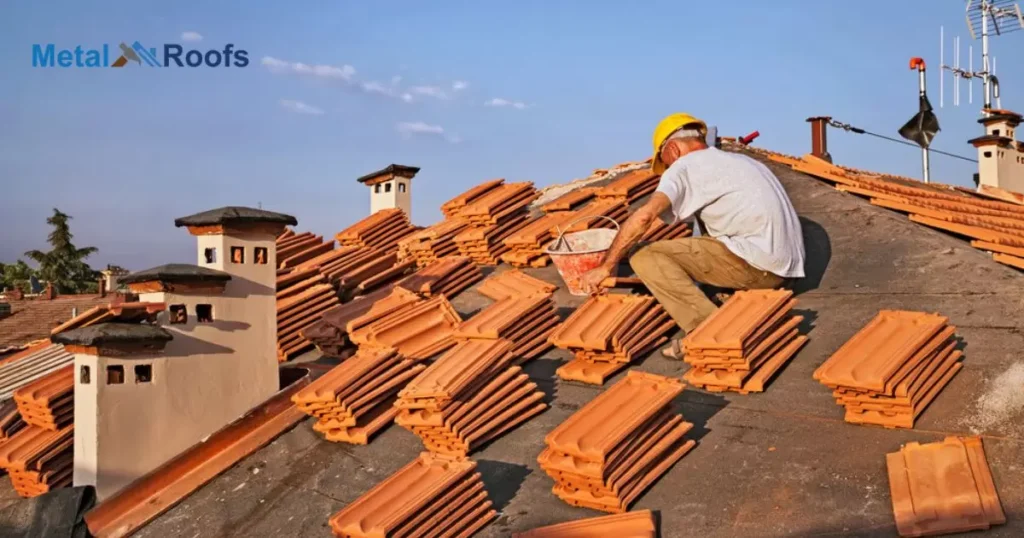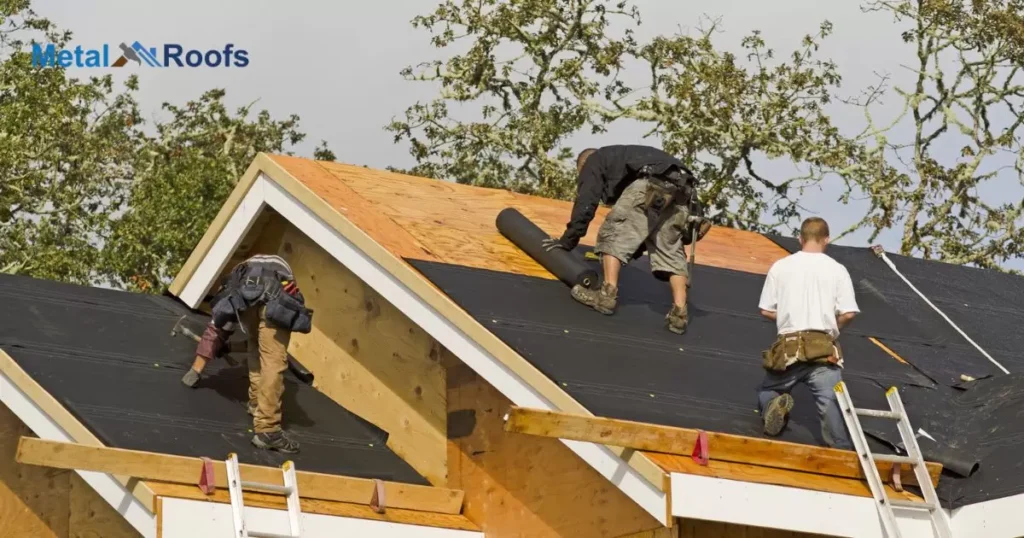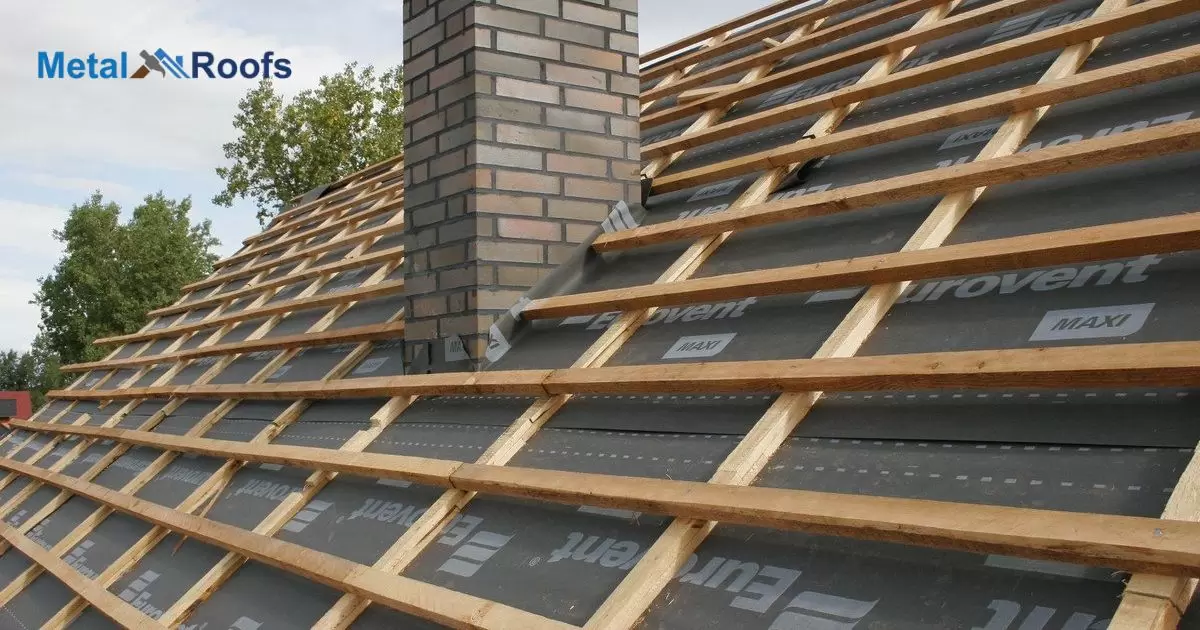Roof underlayment acts as a secondary water barrier under shingles, protecting the house from leaks. It also serves as a weather barrier around the home like house wrap, keeping out drafts and moisture before siding is installed.
Roofs and walls work together to protect homes. An often overlooked product, synthetic roof underlayment, acts as a barrier for both. It resists water under shingles but also air and moisture behind siding, like a house wrap. This multi-use material maximizes leak and weather protection.
Synthetic underlayment is an improvement over felt paper. It lasts longer under shingles. The woven or spunbond fabric is also permeable. So it resists liquid water but lets water vapor pass through. This permeability is crucial for house wrap performance.
Key Takeaways
- Roof underlayment and house wrap serve different purposes in construction.
- Synthetic underlayment is preferable for roofs due to its enhanced water resistance and UV protection.
- Using house wrap on a roof is not recommended as it may not provide sufficient protection against water infiltration.
- When installing metal roofing, consider factors such as roof slope and the type of metal to ensure durability and proper drainage.
Understanding Synthetic Roof Underlayment and House Wrap
Synthetic roof underlayment and house wrap serve distinct purposes in construction. Roof underlayment safeguards roofs from water infiltration, made of materials like asphalt or synthetic polymers. House wrap, however, acts as an air and moisture barrier for exterior walls, crafted from materials such as polyethylene or polypropylene.
Each material has unique characteristics tailored to its specific role. Roof underlayment focuses on water resistance, providing an extra layer beneath roofing materials. House wrap prioritizes air and moisture control, preventing infiltration while allowing vapor transmission. Understanding the differences between these materials is crucial for proper construction practices.
Considerations for Metal Roofing Installation

| Consideration | Description |
| Roof Slope | Ensure proper slope for water drainage to prevent pooling and leaks. |
| Metal Type | Choose suitable metal roofing material based on climate and aesthetics. |
| Underlayment Compatibility | Select underlayment compatible with metal roofing for enhanced protection against leaks. |
| Code Compliance | Adhere to local building codes for structural integrity and safety. |
| Manufacturer Recommendations | Follow manufacturer guidelines for optimal installation procedures and materials. |
| Installation & Maintenance | Employ proper installation techniques and regular maintenance to uphold longevity and structural integrity of the roof. |
When installing metal roofing, consider the slope of your roof. Ensure it’s suitable for the chosen metal roofing material to prevent water pooling. Proper slope promotes water drainage, avoiding leaks.
Selecting the right type of metal roofing, especially when considering birds nesting on the roof, is crucial. Options include steel, aluminum, and copper. Each has different properties and durability. Choose based on your climate and aesthetic preferences.
Impact of Underlayment on Metal Roof Performance
Consider the underlayment’s role in metal roof performance. It acts as a secondary barrier against water intrusion. Choose underlayment compatible with metal roofing materials. Quality underlayment enhances the roof’s longevity. It provides additional protection against leaks and moisture infiltration. Ensure proper installation for optimal performance.
Code Compliance and Manufacturer Recommendations
Before installing a metal roof, ensure compliance with local building codes. These regulations vary by region and dictate installation requirements. Following codes ensures structural integrity and safety.
Ensuring Longevity and Durability of the Roofing System
Proper installation and regular maintenance are essential for a long-lasting metal roof. Inspect for damage and loose components routinely. Clean debris to prevent buildup and maintain structural integrity.
Can I Use House Wrap On A Roof?
Using house wrap on a roof isn’t recommended. It’s designed for walls, not roofs, so it may not provide adequate protection against water infiltration. Roof-specific materials like synthetic underlayment are better suited for this purpose.
Synthetic underlayment offers better resistance to water and UV rays, enhancing the durability of your roof. It also provides a secondary layer of protection beneath the roofing material. Stick to materials designed for roofing to ensure long-term performance and peace of mind.
Types of Synthetic Roof Underlayment

Synthetic roof underlayment is a popular alternative to traditional felt underlayment in roofing applications. It offers various advantages such as better tear resistance, enhanced durability, and improved weather protection. Here are some common types of synthetic roof underlayment:
Polyethylene (PE) Based Underlayment: This type of underlayment is made from polyethylene, a thermoplastic material. It offers excellent tear resistance and durability, making it suitable for harsh weather conditions.
Polypropylene (PP) Based Underlayment: Polypropylene-based underlayment is another popular option. It is lightweight, flexible, and resistant to UV radiation, making it suitable for prolonged exposure to sunlight.
Polyester Based Underlayment: Polyester underlayment is known for its high strength and durability. It provides superior tear resistance and is often used in areas prone to high winds or heavy rains.
Composite Underlayment: Composite underlayment is made by combining different materials such as polyethylene, polypropylene, and polyester. This type of underlayment offers a balance of strength, flexibility, and weather resistance.
Rubberized Asphalt Underlayment: Rubberized asphalt underlayment consists of a blend of asphalt and synthetic rubber. It provides excellent waterproofing properties and is often self-adhesive, making installation easier.
High-Temperature Underlayment: High-temperature underlayment is designed to withstand extreme temperatures without degrading. It is commonly used in areas with hot climates or near heat sources such as chimneys or vents.
Self-Adhesive Underlayment: Self-adhesive underlayment comes with an adhesive backing that allows for easy installation without the need for additional fasteners. It provides a tight seal against water infiltration and is suitable for steep-slope roofs.
Vapor Permeable Underlayment: Vapor permeable underlayment allows moisture vapor to escape from the roof assembly while still providing a barrier against water infiltration. This type of underlayment is commonly used in areas with high humidity levels.
These are just some of the common types of synthetic roof underlayment available in the market. The choice of underlayment depends on various factors such as climate, roof slope, budget, and specific project requirements. It’s essential to consult with roofing professionals to determine the most suitable underlayment for your roofing project.
Frequently Asked Questions
Can roof underlayment be used on walls?
No, roof underlayment is not suitable for use on walls. It’s specifically designed for roofing applications to provide water resistance and is not engineered to perform effectively on vertical surfaces.
What are the disadvantages of synthetic roof underlayment?
Synthetic roof underlayment can be more expensive than traditional felt. It may also be prone to tearing if not handled carefully during installation.
Is roof underlayment the same as tar paper?
No, roof underlayment is not the same as tar paper. While tar paper was traditionally used, modern underlayment materials include synthetic polymers for improved durability and performance.
Conclusion
Synthetic underlayment streamlines roof and wall weatherization. Unlike felt, it handles exposure before shingles are installed. It also replaces a separate house wrap step. The durability and permeability aid performance. Multi-use synthetic underlayment simplifies water and air sealing.
Choosing the right synthetic underlayment is crucial. Look for UV resistance for exposure during roofing. Ensure proper permeability ratings for house wrap use. Get a durable material rated for high wind and foot traffic. Then this single product can provide leak protection as both a roof underlayment and an effective house wrap.











